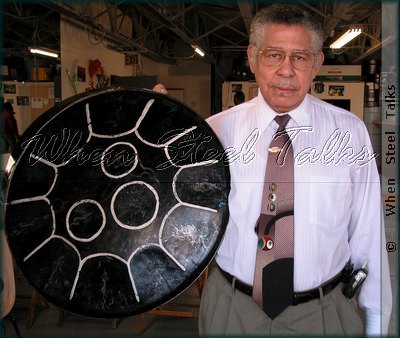Elliot "Ellie" Mannette (born November 5, 1927 in Sans Souci, Trinidad)
Ellie has received countless awards of recognitions. A few include the NEO National Heritage Fellowship Award, Hummingbird Medal of Trinidad and Tobago. In 2003, he was admitted to the Hall of Fame of the Percussive Arts Society of the United States. Ellie was recognized by the Smithsonian Institute in July 2012.
Additional info below posted with special permission from the BestOfTrinidad.com by Ronald C. Emrit - check link for potential updates
| Date of Birth: | November 5, 1927 |
| Place of Birth: | San Souci, Trinidad |
| Date of Death: | August 29, 2018 |
| Education: | Woodbrook C.M. Primary School |
| STEELBANDS: | |
| SPECIALTIES: |
|
 CAREER: Ellie
entered the dawn of the steelband era when he began beating on metal
containers in 1937 at the age of eleven. He joined Alexander's
Ragtime Band in Newtown and later helped organize the "Oval Boys"
band in 1940. The Oval Boys later changed their name to Invaders in
1941. He made significant contributions to the growth of pan by
developing many instruments of the steelband. He was one of eleven
panmen selected to join TASPO as the Trinidad & Tobago
representatives at the 1951 Music Festival in England. He was the
lead tuner on TASPO's 3-month tour of the U.K. CAREER: Ellie
entered the dawn of the steelband era when he began beating on metal
containers in 1937 at the age of eleven. He joined Alexander's
Ragtime Band in Newtown and later helped organize the "Oval Boys"
band in 1940. The Oval Boys later changed their name to Invaders in
1941. He made significant contributions to the growth of pan by
developing many instruments of the steelband. He was one of eleven
panmen selected to join TASPO as the Trinidad & Tobago
representatives at the 1951 Music Festival in England. He was the
lead tuner on TASPO's 3-month tour of the U.K.
On April 10, 2008, a Steel Orchestra Concert was held on the campus of West Virginia University to honor Mannette for his years of service to the university. The orchestra was made up of three steelbands from the universities of Eastern Kentucky, Miami of Ohio, and West Virginia, with guests performance from Andy Narell and Jeff Narell. |
|
AWARDS:
|
|
| Compiled by Ronald C. Emrit | |




